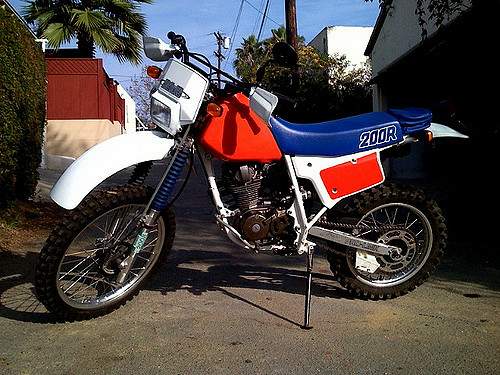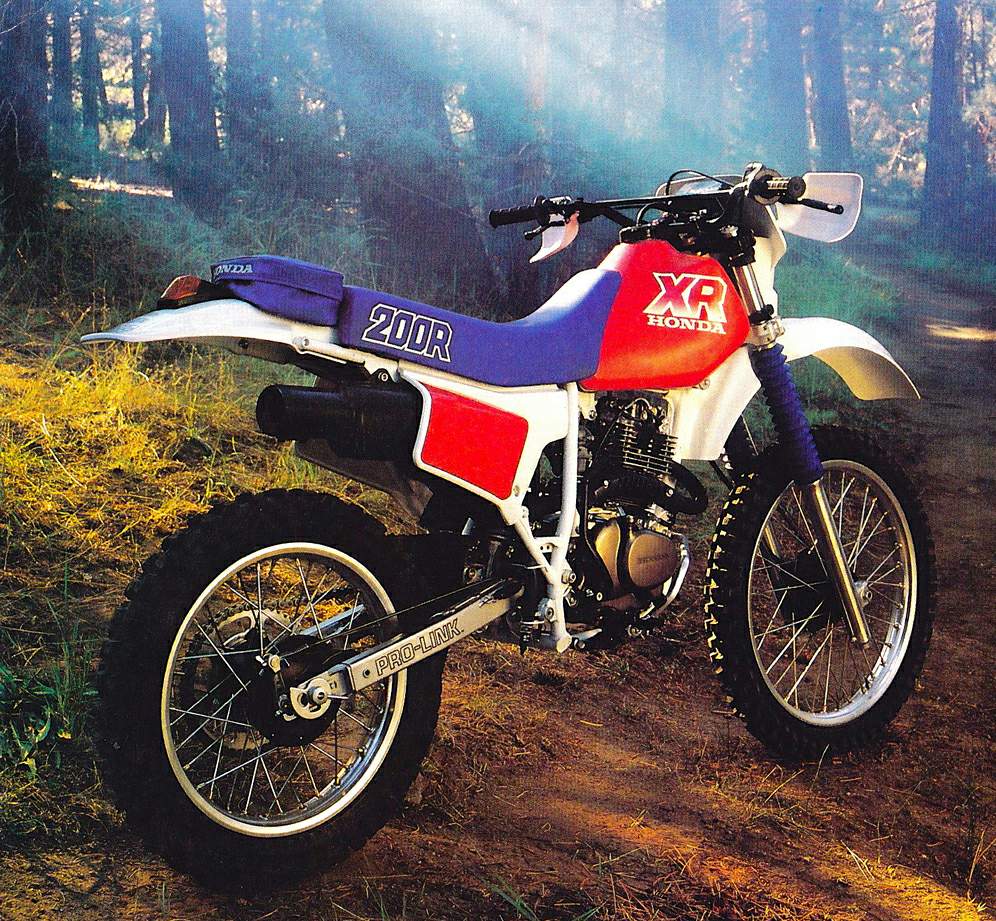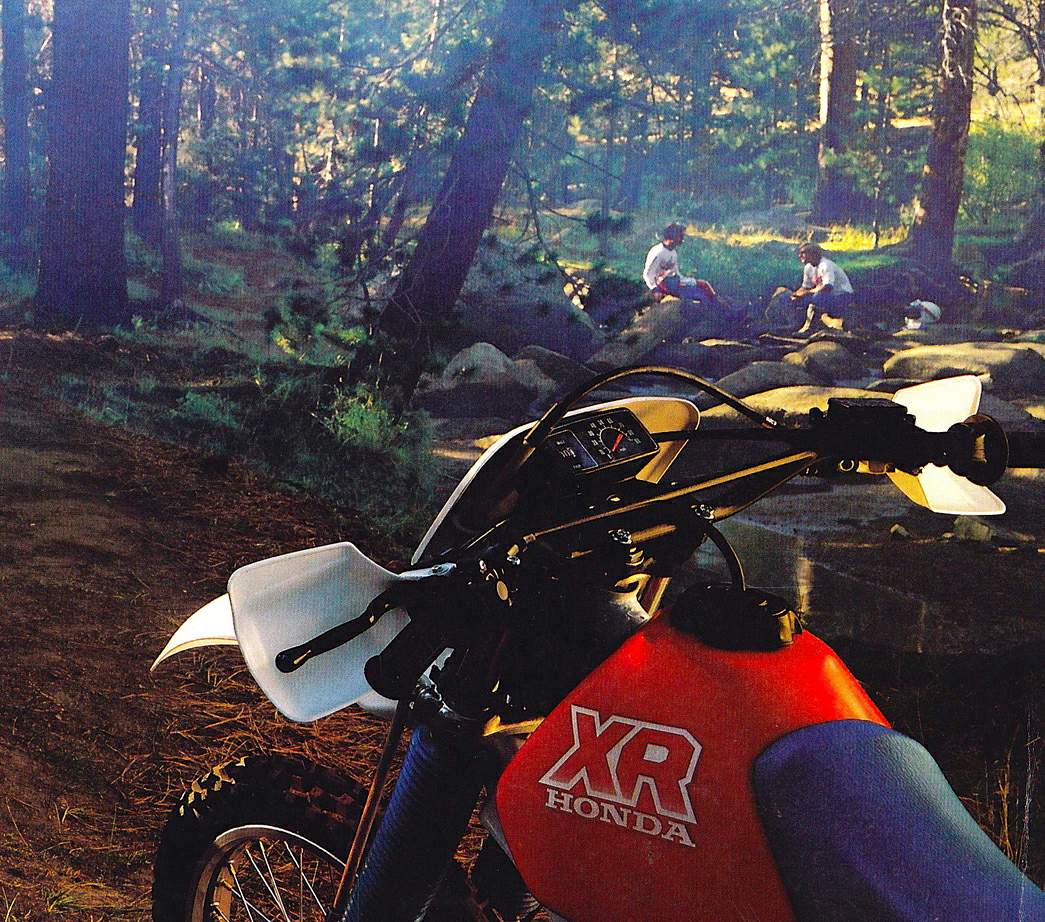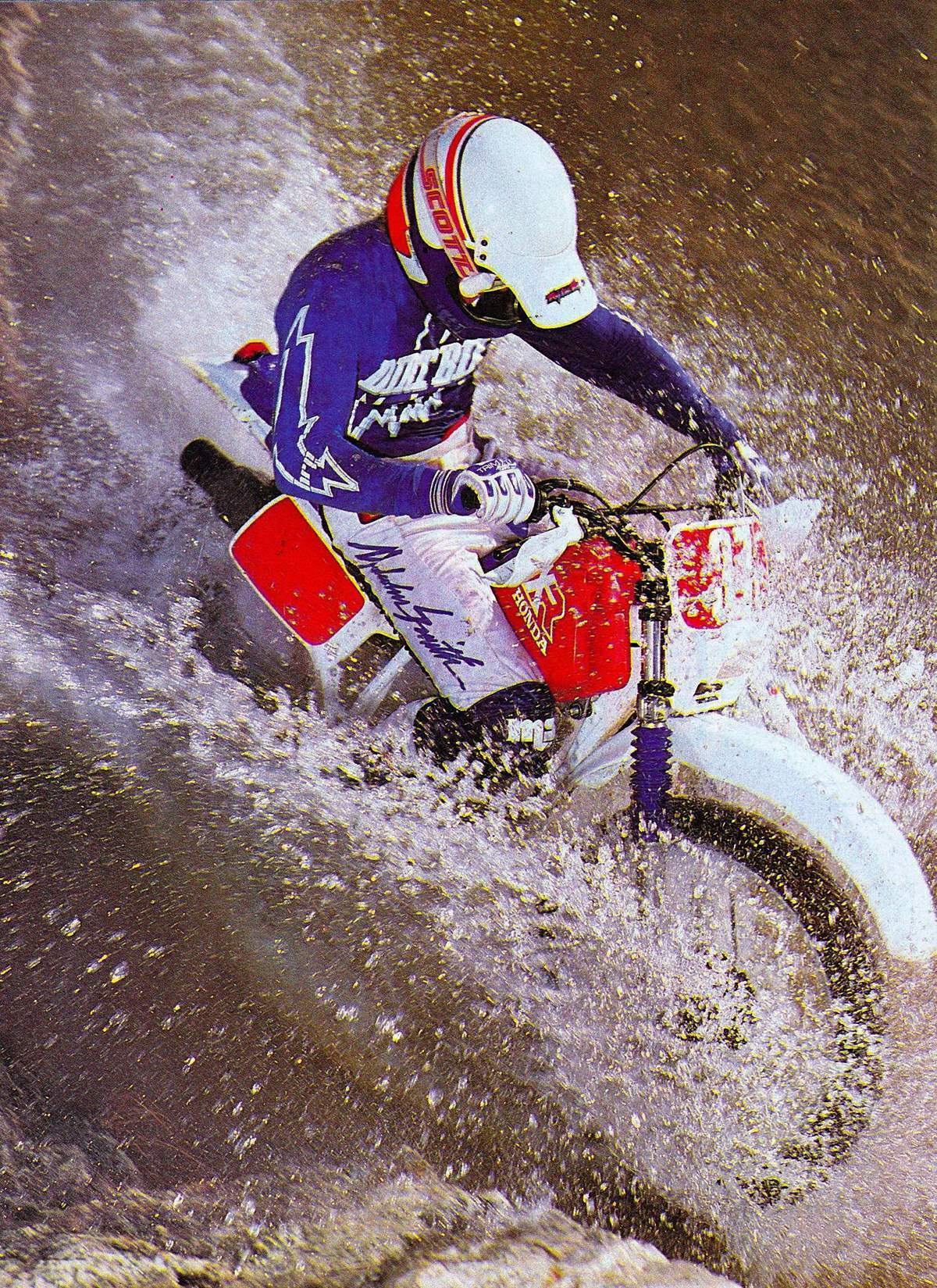
|
|
|
|
|
|
Classic Bikes
Custom Bikes
Individual
Racing Bikes AJP
AJS
Aprilia
Ariel
Avinton / Wakan
Bajaj
Benelli
Beta
Bimota
BMW
Brough Superior
BRP Cam-Am
BSA
Buell / EBR
Bultaco
Cagiva
Campagna
CCM
CF Moto
Combat Motors
Derbi
Deus
Ducati
Excelsior
GASGAS
Ghezzi Brian
Gilera
GIMA
Harley Davidson
Hero
Highland
Honda
Horex
Husaberg
Husqvarna
Hyosung
Indian
Jawa
Kawasaki
KTM
KYMCO
Laverda
Lazareth
Magni
Maico
Mash
Matchless
Mondial
Moto Guzzi
Moto Morini
MV Agusta
MZ / MuZ
NCR
Norton
NSU
Paton
Peugeot
Piaggio
Revival Cycles
Roland Sands
Royal Enfield
Sachs
Sherco
Sunbeam
Suzuki
SWM
SYM
Triumph
TVS
Ural
Velocette
Vespa
Victory
Vincent
VOR
Voxan
Vyrus
Walt Siegl
Walz
Wrenchmonkees
Wunderlich
XTR / Radical
Yamaha
Zero
Video
Technical
Complete Manufacturer List
|
Honda XR 200R
|
| . |
|
Make Model |
Honda XR 200R |
|
Year |
1987 |
|
Engine |
Four stroke, single cylinder SOHC, 2 valve, chain driven overhead camshaft |
|
Capacity |
195 cc / 11.8 cu-in |
| Bore x Stroke | 67 x 56.5 mm |
| Compression Ratio | 10.2:1 |
| Lubrication | Forced pressure and wet sump |
|
Induction |
2x 20 mm piston valve Keihin carburator |
|
Ignition |
Solid state CD |
| Spark Plug | NGK DR8ES-L |
| Starting | Kick |
|
Max Power |
23 hp / 17.1 Kw @ 9000 rpm |
|
Max Torque |
19.5 Nm / 14.4 lb-ft @ 7500 rpm |
| Clutch | Wet multiplate type |
|
Transmission |
6 Speed |
| Final Drive | Chain |
| Primary Reduction | 3.316 |
| Gear Ratio | 1st 2.769:1 2nd 1.941:1 3rd 1.450:1 4th 1.130:1 5th 0.923:1 6th 0.785:1 |
| Frame | Semi double cradle |
|
Front Suspension |
36 mm Air-adjustable forks with dual Syntallic bushings |
| Front Wheel Travel | 254 mm / 10.0 in |
|
Rear Suspension |
Pro-Link, single Showa shock, adjustable |
| Rear Wheel Travel | 246 mm / 9.7 in |
|
Front Brakes |
Drum, swept area - 86.3 cm2 / 13.3 sq. in. |
|
Rear Brakes |
Drum, swept area - 86.3 cm2 / 13.3 sq. in |
|
Front Tyre |
3.00/21(6PR) |
|
Rear Tyre |
110/90/17(6PR) |
| Rake | 26° |
| Trail | 105 mm / 4.1 in |
| Dimensions |
Length 2035mm / 80.1 in Width 865mm / 34.1 in Height 1180mm / 46.5 in |
| Wheelbase | 1365 mm / 53.7 in |
| Seat Height | 905 mm / 35.6 in |
| Dry Weight | 102 kg / 224.8 lbs |
|
Wet-Weight |
109 kg / 240 lbs |
| Ground Clearance | 315 mm / 12.4 in |
|
Fuel Capacity |
9.0 Litres / 2.4 gal |
| . |
Dirt Bike Rider Review 1986
If you're like most people, the first thing you'll notice when you glance at the latest version of Honda's XR200R is the new red, white and blue color scheme and the catchy tank and seat graphics. A closer look, however, reveals a much more important change: For the first time since 1983, the little XR comes with a two-valve engine, something that had us confused at first but began to make more sense as we thought about the type of rider who'll be interested in this kind of machine.
While the XR's 36mm forks aren't the biggest set of tubes around, they're more than enough to handle what the 200 can dish out. Cornering is accurate, and this trait allows a rider to make surprisingly good time through the woods and along tight trails.

TAKING A CLOSER LOOK
To fully understand the reason Honda abandoned the higher-performance RFVC four-valve thumper that powered the XR200R for the past few years, it helps to look back on the development and marketing history of the XR200 series. The story of the 1986 XR200 is actually that of two parallel development programs coming together. For the past five years, Honda has, in fact, offered two XR200 models—the 200 "R," and a less expensive, less technologically sophisticated "playbike" version—the "standard" XR200. The latter was a composite of parts left over from previous "R" model production runs, and as such was always a year or two dated when it came to engine and suspension tech. When the 200R got the Pro-Link treatment, the "plain Jane" made do with a standard two-shock setup. When the R got the four-valve high-performance RFVC engine, the playbike continued to be offered with the old reliable two-valve motor which, while less powerful, was easier to ride and maintain.
The funny thing was, Honda's sales figures indicated that the standard XR200 playbike was far more popular than its more expensive high-tech brother. This fact, coupled with the prospect of the increasingly high R&D expenditures needed to keep the RFVC R model competitive with the two-stroke competition, led to Honda's rethink of the XR and production of the 1986 "hybrid" thumper.
The dirt riding public, it seems, liked the power, tractability and ease of maintenance of the old-style two-valve engine but were no longer satisfied to plonk around with the less sophisticated chassis. The 1986 200R is essentially a composite of its two predecessors, offering the simpler engine design in a high-tech wrapper.

GIVE 'EM WHAT THEY WANT
Combining the high-performance Pro-Link chassis with the two-valve engine was an interesting idea, and in reality the package works exceptionally well in the right environment. Honda made only minor changes to the already proven 1985 rolling stock—the '86 bike has the same forks, shock and frame components that worked so well last year, with only a few new plastic parts here and there; The "new" engine is essentially the same powerplant that's serviced a long line of street, dual-purpose and off-road iron, as well as a few ATVs. It's a breeze to start, the only problem being the kickstarter's tendency to tuck in at the end of the stroke, where the lever catches on the frame, preventing its return. Weird.
Once under way, the motor thumps out power that's mellow, tractable, and, in the case of newer riders, forgiving. There's no tendency to bog when the throttle is rolled on, even when you've been lugging along the trail at just above idle.
TRAILSIDE MANNERS
Riding the XR along tight trails and through wooded sections is an absolute pleasure. The suspension action is sit-down plush, and the comfortable riding position combined with accurate steering let the thumper dart through saplings like a frenzied bobcat. The overall suspension package is more than a match for the kind of situations that many riders are likely to get into, though more accomplished pilots will quickly push both front and rear suspenders to the limit. About the only complaint the beginner through intermediate riders had was the forks' tendency toward harshness in the initial portion of the stroke, the rest of their movement being almost ideal for those in the 140-to-160-pound range.
They work smoothly from mid-stroke on, and bottom with a soft hydraulic cushion over the largest obstacles. Likewise, the rear Pro-Link offers exceptional performance for a machine of this size, delivering a smooth ride in the slow sections, while maintaining its poise over rim-bending hurdles.

SLOWING THINGS DOWN
As with last year's XR, the 1986 model sports drum brakes at both ends. The front binder is excellent: It's progressive and packs enough "stickum" to lock the wheel if the rider is so inclined. The rear is good, but feel at the pedal is mushy, and the pedal rides a little low for our tastes, even when adjusted to its highest position, where it hits the engine case and prevents further upward mobility. Grinding a small section of the lever allows it to rise enough to keep your toes out of harm's way.
MISCELLANEOUS TIDBITS
Seating position and control layout are superb. No one had a single comfort-related complaint, and aside from the aforementioned brake pedal gripe, the XR's rider-input devices all scored high marks. Shifting is just a little notchy, though it is precise. Overall, the XR's gear ratios are good, but on killer hillclimbs we'd like to see less of a jump from second to third—the 200 just doesn't have enough zing to span the gap when the going gets really ugly. Overall power output isn't earthis, after all, a lightweight 200, and we'd say the machine is ideal for beginners right on through to B-level enduro riders, who frequent the kind of tight, twisty terrain for which the XR was designed. In this type of situation, the machine is hard to fault. We'd also like to point out that there are probably more hop-up parts available for this engine than any ever built, just in case you decide more power is needed later on.
AND IN CLOSING..
The bottom line is this: If you're looking for a lightweight, reliable, easy-to-ride machine that's not a throwback to the technological Stone Ages, and is big on fun while being easy on the pocketbook, the XR200R is hard to beat. Even with two fewer valves than last year's bike, it still looks like Honda has a winning number.
Source Dirt Rider 1986

|
Any corrections or more information on these motorcycles will be kindly appreciated. |